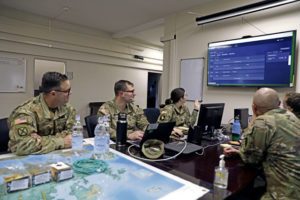
Interoperability with Allied forces is a top Department of Defense priority. According to the Netherlands Army officers who visited 21st Theater Sustainment Command in November, the Dutch have created a web-based tool that will make multi-national sustainment planning faster and more accurate.
“We created an interactive host nation support system which allows all the participating countries to have a smooth operation,” said Second Lt. Daan Verwaaij, a Dutch Army officer. “Instead of papers, spreadsheets, and emails, it’s all electronic within the system.”
Over two days, Verwaaij and his colleagues Maj. Geert Vanhaastrecht and Maj. Peter Gijsbers, both Dutch Army officers, walked 21st TSC Host Nation Support staff through the web-based system, dubbed iHNS, in development since 2018. The objective of their visit was to help the U.S. get started on the system and set the stage for other countries to follow.
“The expansion to other countries is one of the major milestones we want to achieve,” said Gijsbers
Lt. Col. Scott Gum, Chief of the 21st TSC Theater Movements Center, said the program could be useful throughout the 21st TSC. “This tool that the Netherlands has built helps us communicate all together instead of having one-offs, emails and phone calls from different people,” he said. “A lot of different sections across the 21st have requirements, so even though it’s the iHNS system that we are looking at, it’s not just host nation support. There’s transportation requests, the Theater Movements Center is involved, there’s security. We are exploring what’s possible for potentially using it for Defender 22 and beyond.”
One of the major benefits of iHNS, is that it eliminates multiple emails and telephone calls, according to Vanhaastrecht. “Now you have one complete overview of everything that’s required for an operation in one place, and there’s only one version of it, so there’s no differences in the version of the statement of requirements.”
Planners will no longer have to keep track of spreadsheets going back and forth, or be unsure if they have the latest version. “In this case, when you log in, that is the latest version, always,” said Gijsbers.
In the past, relying on outdated information has resulted in mishaps ranging from not having enough supplies to missing rendezvous. “Forces were crossing a border at one point and the host nation forces that were expecting the crossing forces were at another border crossing point because the information wasn’t shared correctly,” recalled Verwaaij.
Capt. Michael McKinney, 21st TSC TMC, provided another example of the importance of being able to share information in real time. “Say the number of personnel changes coming in,” he said. “And on one spreadsheet there were 50 people, but the actual number coming in is 60 or 70. If the folks in the Netherlands didn’t get the right information from the United States planners, the 70 people are going to show up and there is not enough food or water and all the things that they need. This tool ensures that inefficiencies like that are eliminated.”
Planners will also benefit from being able to review and learn from previous operations that are archived in the system. “We’ve got a lot of extra situational awareness because of the functionalities,” said Vanhaastrecht. “Those are major benefits compared to the old process.”
iHNS also allows for faster planning. “The system is interactive, so we don’t need to wait, for instance, until a statement of requirements is entirely complete,” said Verwaaij. “We can already start planning everything, doing the biggest things, without having to wait for the final information. This will help us to be able to execute much faster in the execution phase.”
He added that the system will be continuously improved as more nations adopt it, and provide feedback.
He said it was natural for the Netherlands to take the lead in developing iHNS. “We see ourselves as the gateway to Europe, and for the Allied Forces,” he said. “We saw a lot of inefficiencies in the current process and we came up with this idea as the smartest way to fix those problems. We chose to do it this way to achieve quick success and get quick wins and to improve the process as fast as possible. “
The Dutch contingency said it also made sense for the U.S. to be an early adopter, as it is one of the biggest consumers of host nation support services. They culminated their 21st TSC visit by “going live” with Host Nation Support and inputting information for Defender 22.
John Kizler, Chief, International Logistics, HNS Branch, who helped develop the application with the Netherlands, sees the tool as a step forward in improving Host Nation Support collaboration to support rotational mission and exercise logistics, as well as security and transportation requirements. “iHNS enables the command and the Netherlands to rapidly communicate requirements and validate HNS in hours versus days,” said Kizler. “Our HNS team looks forward to work with the Netherlands to conducting a proof of principle of this application for upcoming rotational force missions and validate the system for Exercise Defender 22.”


